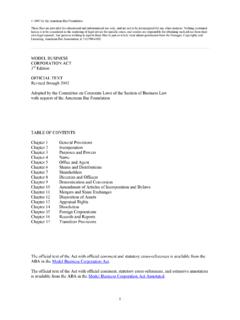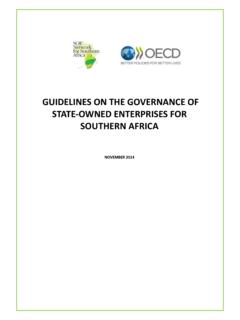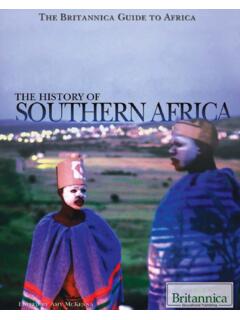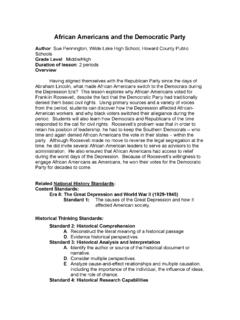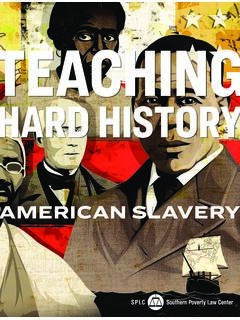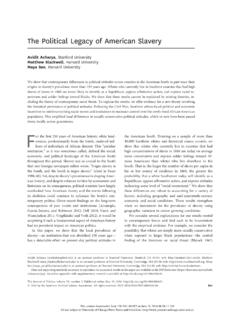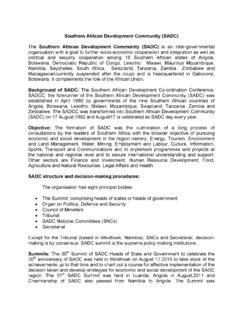Transcription of Records of Southern Plantations from Emancipation to the ...
1 A Guide to the Microfilm Edition ofRecords of Southern Plantationsfrom Emancipation to the Great MigrationSeries B: Selections from the Louisiana and Lower Mississippi ValleyCollections, Louisiana State University LibrariesPart 4: Mississippi Cotton PlantationsCover: (top left) the steamboat Ouachita, loaded with cotton bales; (top right)workers in field; and (bottom) laborers in front of store on Belle Grove sugarplantation. Photos courtesy of Louisiana State University of Southern Plantations fromEmancipation to the Great MigrationGeneral Editor: Ira BerlinSeries BSelections from the Louisiana and Lower Mississippi ValleyCollections, Louisiana State University LibrariesPart 4: Mississippi Cotton PlantationsAssociate EditorMartin SchipperGuide compiled byDaniel LewisLibrary of Congress Cataloging-in-Publication DataRecords of Southern Plantations from Emancipation to the great migration.
2 Series B,Selections from the Louisiana and Lower Mississippi Valley Collections, LouisianaState University Libraries [microform] / general editor, Ira Berlin,microfilm by a printed guide compiled by Martin Schipper and Daniel Lewis,entitled: A guide to the microfilm edition of Records of Southern Plantations fromemancipation to the great : pt. 1. Louisiana sugar Plantations --pt. 2. Louisiana cotton Plantations --pt. 3. Louisiana sugar Plantations (Bayou Lafourche and Bayou Teche)--pt. cotton Plantations --pt. 5. Albert Batchelor papers--pt. 6. Weeks 1-55655-872-4 (part 1)--ISBN 1-55655-873-2 (part 2)--ISBN 1-55655-874-0(part 3)--ISBN 1-55655-895-3 (part 4)--ISBN 1-55655-917-8 (part 5)--ISBN 1-55655-918-6 (part 6)1.
3 plantation life-- Southern States--History--19th plantation life-- Southern States--History--20th century--Sources. 3. AfricanAmericans-- Southern States--History--19th century--Sources. 4. AfricanAmericans-- Southern States--History--20th century--Sources. 5. Plantationowners-- Southern States--Archives. 6. Southern States--History--1865-1951--Sources. 7. Reconstruction-- Southern States--Sources. I. Berlin, Ira, 1941-II. Schipper, Martin. III. Lewis, Daniel, 1972- . IV. Louisiana State UniversityLibrary. V. University Publications of America (Firm). VI. Title: Selections from theLouisiana and Lower Mississippi Valley Collections, Louisiana State UniversityLibraries. VII. Title: Guide to the microfilm edition of Records of Southern plantationsfrom Emancipation to the great '.
4 04--dc21 2002066158 CIPTABLE OF CONTENTSI ntroduction vScope and Content Note xiNote on Sources xiiiEditorial Note xiiiReel IndexReel 1 Audley Clark Britton Family Papers, 1830-1929 [1860-1929], Adams County,Mississippi 1 Reel 2 Capell Family Papers, 1816-1900 [1860-1900], Amite County and WilkinsonCounty, Mississippi 2 Reels 3-4 Eli J.
5 Capell Family Papers, 1840-1932 [1860-1932], Amite County,Mississippi 4 Reel 5 Eli J. Capell Family Papers cont 7 Stephen Duncan Family Papers, 1817-1877 [1863-1877], Adams County,Mississippi 8 Eggleston-Roach Papers, 1825-1903 [1860-1903], Warren County,Mississippi 8 James A. Gillespie Family Papers, 1776-1931 [1866-1931], Adams County,Mississippi; also Concordia Parish, Louisiana 8 Reels 6-8 James A.
6 Gillespie Family Papers cont 9 Reel 9 William Newton Mercer Papers, 1789-1936 [1860-1936], Adams County,Mississippi 11 Reel 10 William Newton Mercer Papers cont 13 Joseph Addison Montgomery Papers, 1806-1886, Claiborne County,Mississippi 14 Reel 11 Pugh-Williams-Mayes Family Papers, 1844-1933 [1845-1900],Coahoma County, Mississippi 16 Reel 12 Salisbury plantation Papers, 1858-1900, Wilkinson County, Mississippi 17 Joseph D.
7 Shields Papers, 1802-1960, Adams County, Mississippi 17 Reels 13-15 Joseph D. Shields Papers cont 19 Subject Index 23 INTRODUCTIONNo institution was more central to the transformation of Southern society between theend of the Civil War and the beginning of the Great Migration than the plantation . Since theseventeenth century, the plantation with its powerful "masters" and their retinue ofenslaved black laborers had been the productive center of Southern society, as well as itsprimary social and political institution.
8 Planters controlled the politics of the South, shapedits society, and dominated its culture. It is no exaggeration to say that the antebellum Southcannot be understood without a firm grasp of the meaning of the plantation , as most whitesoutherners aspired to the planter class and most black southerners wanted nothing morethan to escape its long Civil War destroyed the plantation as southerners had known it. The war itself leftmany estates in ruins, their tools and implements wrecked, animals decimated, fields inruins, and buildings devastated. The Emancipation of some four million slaves thataccompanied the war stripped planters of their labor force, their wealth, and their politicalauthority, giving former slaves proprietorship of their own persons and, with that, aspira-tions for economic independence and political power.
9 At war's end, the old order was nomore, and no one knew what would replace it. It soon became evident, however, that theplantation would not disappear. Instead, it would be reformulated, as would the lives ofthose men and women associated with the great estates. For this reason, any understand-ing of the postwar world must be accompanied by a close reading of the Records of plantation Records trace the torturous process of resurrecting agriculturalproductivity and restoring social stability to the American South. The outline of the story iswell known--although scholars continue to debate its meaning by discovering new factsand reinterpreting old ones. The destruction of chattel bondage set in motion a contest ofexpectations, as former slaves and former slaveholders--joined by white and blacknonslaveholders and northern soldiers, missionaries, and would-be planters and politi-cians--struggled to create a new regime that spoke to their diverse and often opposingaspirations.
10 The freedpeople's desire for economic independence, social autonomy, andpolitical power was initially met by a steely opposition from former masters and other whitesoutherners that ranged from determined attempts to reinstate the old regime to sullenacquiescence. In the half century that followed, the aspirations of black people remainedunaltered, although the changes in the political terrain forced them to modify the tactics andstrategies they hoped would achieve them. Meanwhile, some former slave masters lostcontrol of their land to upstart merchants, fell from prominence, or transferred their capitalto newer industrial enterprises. Some of the men who took control of Plantations weredrawn from the ranks of white nonslaveholders.





